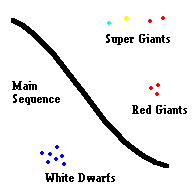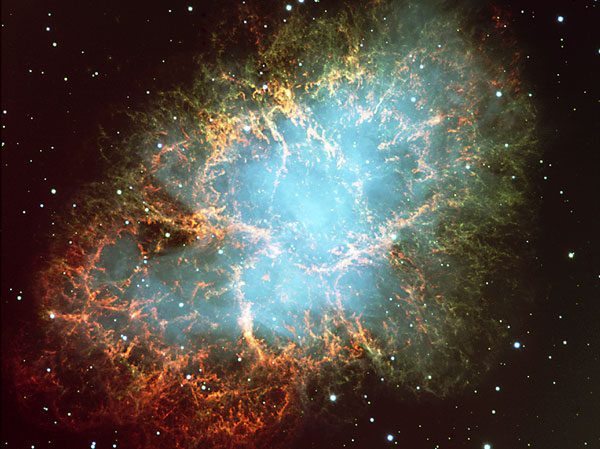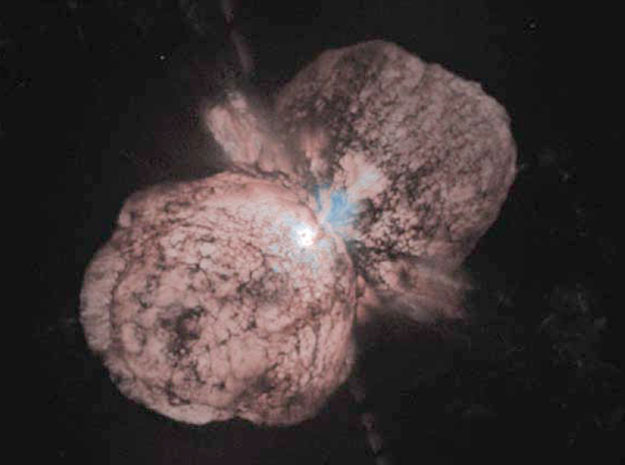
Although very rare, high mass stars (several times the mass of our sun) die in spectacular fashion, and their deaths are extremely important for you and me. After a high mass star uses up its hydrogen fuel in the core (changing it to helium), it simply starts fusing the helium to carbon. At the same time the star initiates a shell of hydrogen to helium fusion directly outside the core. The star reconfigures itself as a super giant star on the H-R diagram, ... growing to a size 100 - 1000 times that of the sun. Without turning you into physics majors, the reason the star fails to explode at this point is because there is sufficient pressure from overlying layers that it is able to "contain" these reactions. The star does, however, become rather unstable, ... shifting its position in the upper sections of the HR diagram.

 |
Deep inside a super massive star (animation)
The story of super giants gets even stranger. The carbon core contracts further, and reaches high enough temperatures to fuse carbon to neon, then neon to oxygen, then oxygen to silicon, then finally silicon to iron. All this time, layers above the core are also undergoing fusion reactions. The animation above shows a complex series of nuclear reactions which are simultaneously going on deep in the interior of these massive stars.
Things really get interesting when you reach the element iron. Iron has the most stable nucleus of all the elements on the periodic table. As iron starts accumulating in the core of these stars, it really doesn't do much at all. It just accumulates. Subrahmanyan Chandrasekhar (Chandra) was a young astronomer who worked out the dynamics of the interior of stars. He explained why a white dwarf would not collapse (remember it has no nuclear reactions). He said the outer electrons in the atoms exerted a pressure to resist the collapse. In the process, he was able to show that if a white dwarf were to exceed a mass of 1.4 solar masses, it would produce sufficient forces to overcome the electron pressure and the white dwarf would collapse. This value is still known as the Chandrasekhar limit (he was only 19 when he discovered this). Why do we bring this up here? Because the iron core of these massive stars is held up by the same electron pressure ... and just like the white dwarf, it can only take so much external pressure. It is as if you were to pile up empty soda cans, ... one over the other. Eventually you would reach a critical value and the bottom can would collapse from the weight of the cans above.

Credit
NASA
Subrahmanyan Chandrasekhar

The Crab Nebula from VLT
Credit: FORS Team,
8.2-meter VLT, ESO
When the iron core reaches a critical mass, ... it suddenly collapses, ... reaching nuclear densities and it superheats. In addition, the shock wave of this event ripples through all the layers above the core, ... superheating each layer as well. This produces fusion reactions of all kinds resulting in a type II supernova explosion. For one brilliant month, a single star burns brighter than a whole galaxy of 200 billion stars. Supernova explosions inject carbon, oxygen, silicon and other heavy elements up to iron into interstellar space. They are also the site where most of the elements heavier than iron are produced. These heavy elements are ejected into space and eventually become incorporated into future generations of stars and planets. Without supernova, the fiery death of massive stars, there would be no carbon, oxygen or other elements that make life possible. In a very real sense ... we are all made from the death of these massive stars!
If you recall, stars are produced from the gravitational collapse of nebulae. It should now be apparent where a lot of the gas and dust come from, ... recycled stars! However, we need to remember that exploding stars are tossing elements into space, and we need to collect this material back into a compressed form. How is this possible? Supernovae to the rescue.
The shock wave of supernovae aid in the formation and initial collapse of nearby nebulae (which eventually form open star clusters). That is, the nebula needs to be compressed to a critical density before gravity takes over by itself. Shock waves from nearby supernovae have been found to produce this necessary step.

Shock waves of supernovae help make new stars (animation)
A few of the stars in each open cluster will be high mass stars. These stars don't have very long main sequence life spans and will , in turn, go supernova. Their shock wave will aid in the collapse of more of the nebula. In time, the original nebula will be "consumed", and stars will be produced. The debris from each supernova also supplies the area with more gas and dust for the next generation of stars.
Crab Nebula - In 1054 Chinese astronomers reported seeing a "guest star" ... visible even during the daytime. Today we see the result of this type II supernova explosion as the crab nebula. Other notable supernovae occurred in 1572 (Tycho's Supernova) and in 1604 (Kepler's Supernova).
Cas A Supernova
Supernova 1987 A - the most recent supernova visible without the aid of a telescope. When SN1987A was detected, it was the first time a nearby supernova has been found. Unlike earlier supernovae, this time we had high tech equipment in place to obtain accurate measurements. Probably the best evidence to support current theories came when 2 working neutrino detectors literally "pinged the meter" just prior to the initial light blast. This was predicted by theory but now confirmed by hard data.
Major Update: For the first time ever, astronomers have observed (in real time) a red supergiant go supernova!!! Read more here. The unanticipated observation was a sudden increase in luminosity just prior to the collapse and subsequent explosion. The event is known as SN 2020tlf. This stuff is so exciting!

Credit: J. Morse (U.
Colorado), K. Davidson (U. Minnesota)
et al., WFPC2, HST, NASA
Buried deep within the crab nebula are the remains of the collapsed iron core (which got the explosion going in the first place). Only now, it is compressed down to a ball of solid neutrons only a few miles across. Sometimes known as a neutron star, it is also called a pulsar because it spins at incredible rates ... emitting pulses of energy in the process. The mass of a neutron star is over 1.4 times the mass of the sun!!!!
Supermassive Stars
Astronomers have recently discovered some very massive stars. We are talking stars over 100 times the mass of our sun. These stars are causing astronomers to rewrite the books. Currently classified as hypergiants, these stars are very hot (50,000 K) and incredibly luminous. They show up in the very upper left corner of the HR diagram. They are several dozen times larger than the sun (big, but nowhere as big as a supergiant).
Astronomers have also discovered explosions even more violent and energetic (10x) than supernovae (recently labeled hypernova). It is believed these two discoveries are related. When these supermassive stars die, they produce hypernovae .... and leave a different surprise in the middle. If the collapsed stellar core has a mass of about 3 solar masses, it would continue to collapse smaller than a neutron star. In fact, the collapse never stops ... so the object collapses down to zero volume (much smaller than an atom)!!!! This is a very strange object having the property that it could gravitationally pull in everything (close by) to itself ... including light. We are talking about a black hole. We will cover these bizarre enigmas of the universe in the next section.
Astronomers are still putting the pieces of this puzzle together and trying
to establish the dividing lines. But part of that puzzle is coming
together when, in late 2019, astronomers discovered the
lowest mass black hole having a mass of just 3.3 times the mass of the sun.
Note the maximum observed mass of a neutron star is 2.19 solar masses (2019).
| Mass of Original Star | Main Sequence lifetime | How it explodes | What it leaves behind |
| less than our sun | longer than the universe is old | it doesn't | white dwarf (which cools to a black dwarf) |
| mass like our sun | about 10 billion years | planetary nebulae | white dwarf (which cools to a black dwarf) |
| slightly more than the sun (> ~ 8 * sol) | a few 100 million years | supernovae | neutron star (if core > 1.4 solar masses) |
| much more than our sun > ~ 60+ * sol | only ~10 million years | hypernovae | black hole (if core > ~3 solar masses) |
ŠJim Mihal 2004, 2014, 2019- all rights reserved